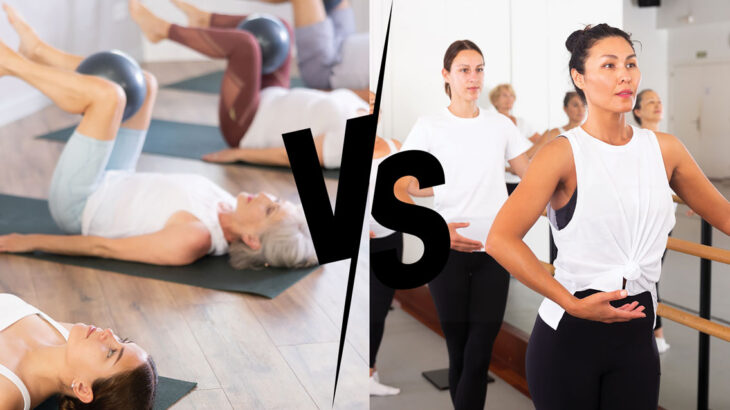If you’re looking for a low-impact workout that builds strength, improves flexibility and tones your body, you’ve probably come across Pilates and barre. Both these workouts are amazing for sculpting lean muscles and improving posture, but they each have unique benefits. So, what’s the difference, and which one should you try? Let’s break it down.
WHAT IS PILATES?

Pilates is a full-body workout that focuses on core strength, stability and controlled movements. Developed by Joseph Pilates in the early 20th century, this method emphasizes precision, breathwork and alignment to improve posture, flexibility and muscle endurance.
PILATES BENEFITS:
- Core strength: Pilates is well known for targeting the deep core muscles, helping to create a strong, stable center.
- Improved flexibility and mobility: The controlled movements stretch and lengthen muscles while strengthening them.
- Better posture: Many Pilates exercises help correct misalignment and strengthen postural muscles, reducing back pain.
- Low-impact and gentle on joints: Great for injury prevention and recovery, as well as prenatal and postnatal fitness.
TYPES OF PILATES:
- Mat Pilates: Uses bodyweight exercises on a mat, sometimes incorporating props like resistance bands or small weights.
- Reformer Pilates: Uses a special machine (the reformer) with springs and pulleys to add resistance for a deeper, more intense workout.
WHAT IS BARRE?

Barre is a ballet-inspired workout that blends elements of dance, Pilates and strength training. It involves high repetitions of small, isometric movements using light weights, resistance bands or body weight. Many barre workouts incorporate a ballet barre for balance and stability (hence the name!).
BARRE BENEFITS:
- Tones and sculpts muscles: The small, controlled movements create a burnout effect in muscles, leading to serious toning.
- Improves endurance and stamina: The high reps and pulsing movements challenge muscle endurance.
- Boosts balance and coordination: The combination of ballet-inspired moves and core engagement helps with stability.
- Great cardio alternative: While not a traditional cardio workout, barre increases heart rate and burns calories through continuous movement.
TYPES OF BARRE:
- Traditional barre: Follows classic ballet-inspired movements and strength exercises at the barre.
- Cardio barre: Adds a faster pace and aerobic components for a heart-pumping workout.
- Fusion barre: Combines barre with Pilates, yoga or even strength training for a more dynamic workout.
WHICH ONE SHOULD YOU TRY?
- Choose Pilates if: You want to build core strength, improve flexibility and enhance mobility. It’s great for posture correction, injury prevention and recovery.
- Choose barre if: You love high-energy, dance-inspired workouts that sculpt and tone with a focus on endurance and small, precise movements.
- Want the best of both worlds? Many fitness studios offer Pilates-barre fusion classes, blending the deep core work of Pilates with the sculpting moves of barre.


